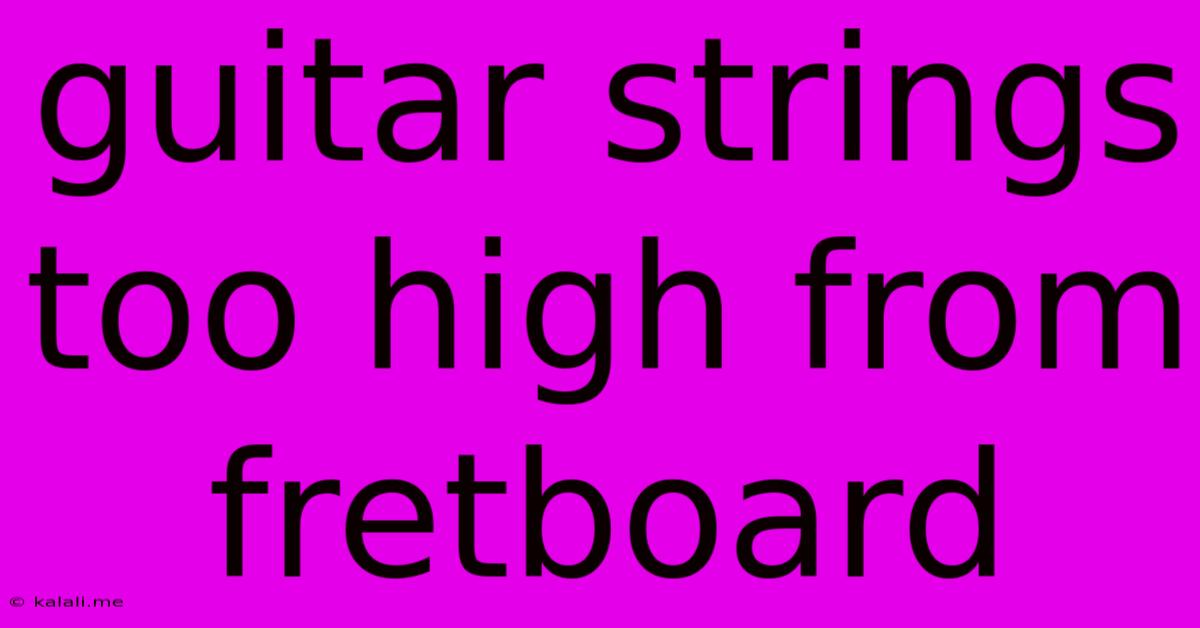Guitar Strings Too High From Fretboard
Kalali
Jun 01, 2025 · 4 min read

Table of Contents
Guitar Strings Too High From Fretboard: Troubleshooting and Solutions
Having your guitar strings too high from the fretboard is a common problem that can significantly impact playability and comfort. A high action (the distance between the strings and the fretboard) makes it harder to fret notes cleanly, leading to buzzing, discomfort, and potentially hindering your playing progress. This article will guide you through troubleshooting this issue and provide solutions you can implement, from simple adjustments to more involved setups.
Understanding High Action: Why It Happens and What It Means
High action isn't always a problem requiring immediate fixing; some guitarists prefer a higher action for specific playing styles. However, excessively high action is almost always detrimental. Several factors contribute to this:
- High bridge saddle: The most common culprit, this is easily adjustable on many guitars.
- High nut: The nut, located at the headstock, can also contribute to high action. This requires more specialized tools and care.
- Warped neck: A neck that's bowed or twisted can significantly affect string height. This is a more serious problem often requiring professional attention.
- Incorrect truss rod adjustment: The truss rod, a metal rod within the neck, controls neck relief (the slight curve in the neck). Improper adjustment can lead to high action.
Diagnosing the Problem: Pinpointing the Cause
Before you start adjusting anything, it's crucial to identify the source of the high action. Here's how:
- Check the bridge saddle height: Look at the bridge saddles; are they significantly higher than you'd expect? This is often the simplest fix.
- Measure the string height: Use a ruler or a specialized guitar setup tool to measure the string height at the 12th fret. Compare this to standard string height recommendations for your guitar type.
- Examine the neck for warping: Look down the neck from the headstock to the body. Is the neck straight, or does it show any bowing or twisting? A warped neck often requires professional attention.
- Assess the nut height: Inspect the nut slots; are they excessively high? This usually requires specialized tools and expertise.
Solutions: Fixing Your High Action
Once you've identified the problem, you can take steps to resolve it.
1. Adjusting the Bridge Saddles: This is the most accessible solution for many guitars.
- Identify the bridge saddle adjustment screws: Most bridges have small screws that allow you to raise or lower the saddles.
- Use the correct tools: Use a small screwdriver appropriate for the screws. Don't overtighten.
- Make small adjustments: Lower the saddles incrementally, retesting after each adjustment to avoid going too low.
2. Adjusting the Truss Rod: This requires caution; incorrect adjustment can damage your guitar.
- Consult your guitar's manual: It will contain instructions specific to your instrument.
- Make tiny adjustments: Turn the truss rod adjustment nut only a fraction of a turn at a time. Wait several hours for the wood to settle before making further adjustments.
- Seek professional help if unsure: Improper truss rod adjustment can cause significant damage.
3. Addressing a Warped Neck: A warped neck is a serious issue requiring a professional luthier.
- Don't attempt DIY fixes: Trying to fix a warped neck yourself can cause irreversible damage.
- Consult a professional: A luthier has the expertise and tools to diagnose and repair the problem.
4. Nut Slot Adjustment: Adjusting the nut is a more advanced task best left to a professional.
- Precise tools are required: This requires specialized tools and careful work.
- Incorrect adjustments can damage your guitar: Improper nut adjustment can negatively impact playability and tuning stability.
Preventing High Action: Regular maintenance is key.
- Regularly check string height: Regularly inspect your guitar's action to catch any issues early.
- Proper storage: Store your guitar in a stable climate to prevent wood from expanding or contracting excessively.
- Professional setup: Consider getting a professional guitar setup every six months or so, especially if you notice changes in playability.
By following these steps, you should be able to address your high action issue. Remember that patience and precision are key. If you are unsure about any of these steps, it's always best to consult a professional guitar technician or luthier. They possess the skills and experience to ensure your guitar is set up correctly and plays optimally.
Latest Posts
Latest Posts
-
Was There Exponential Growth Of Inflation
Jun 03, 2025
-
Difference Between Oxygen Sensor Bank 1 And Bank 2
Jun 03, 2025
-
Grout Or Caulk Where Tile Meets Tub
Jun 03, 2025
-
Can You Take Bear Spray On A Plane
Jun 03, 2025
-
Could Not Resolve Host Raw Githubusercontent Com Istore
Jun 03, 2025
Related Post
Thank you for visiting our website which covers about Guitar Strings Too High From Fretboard . We hope the information provided has been useful to you. Feel free to contact us if you have any questions or need further assistance. See you next time and don't miss to bookmark.